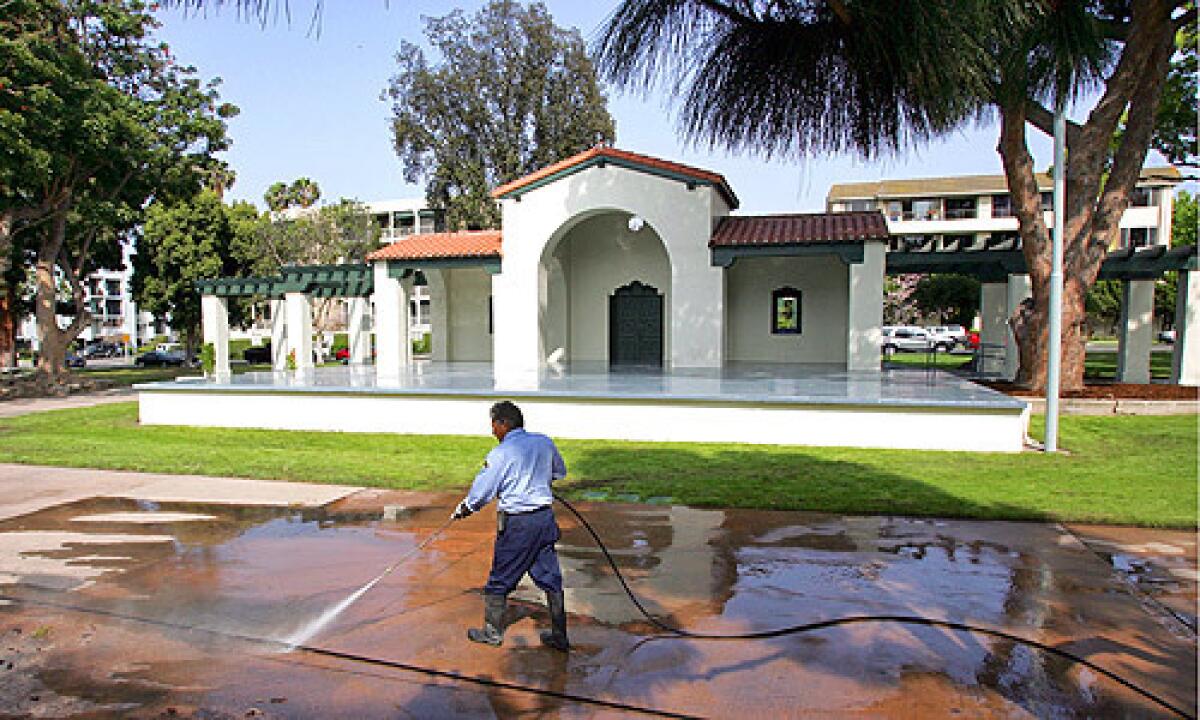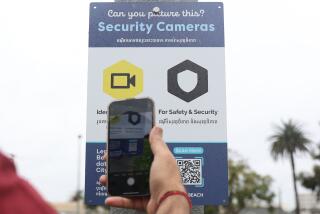Historic Long Beach band shell is restored to its former glory

- Share via
The Bixby Park Bandshell isn’t really a shell, but the name is ingrained in the Long Beach vernacular.
The 1923 Spanish Colonial Revival open stage in Long Beach looks nothing like the grand, curving band shells of Boston and Chicago. “There’s supposed to be a shell. It’s supposed to be rounded so that the sound comes out to the people,” said Long Beach historian Stan Poe.
FOR THE RECORD:
Herbert Hoover: A caption in Sunday’s California section with the L.A. Then and Now column about the Bixby Park Bandshell said the photo showed President Hoover in 1928. Hoover was not president when the photo was taken; he became president in 1929. —
Yet generations of park- goers have called the graceful, cream-stucco building the Bixby Park Bandshell. Over the decades, the building and the tree-shaded park around it became a popular site for concerts, theater, political speeches and the famous Iowa picnics that helped christen the city “Iowa by the Sea.”
Then a February 2005 windstorm uprooted a large ficus tree that smashed part of the structure. It has stood deserted ever since as city officials hunted for funds to restore it.
On Saturday, a crowd of 500 celebrated the building’s reopening at a festival featuring free food, theater performances, vintage cars and live music. The renovated structure, 100 feet by 28 feet, gleamed with its freshly painted stucco, a new red-tile roof and dark-green trim.
The event carried on Bixby Park’s historic role as a central gathering place for the city of 473,000 on Los Angeles County’s southern coast.
“It’s a place where people have parties all the time: picnics, fiestas, band concerts, antiwar protests,” said Julie Bartolotto, executive director of the Historical Society of Long Beach.
The band shell has been used for celebrations by the city’s Latino, Cambodian and Filipino communities.
But what put the park on the cultural map were earlier waves of immigrants: the Iowans and other Midwesterners who settled in the Long Beach area and held massive annual picnics at the gracious, 17-acre park bounded by Broadway, Cherry Avenue, Ocean Boulevard and Junipero Avenue.
The annual Iowa picnic was the best known of these reunions. Thousands of former Iowa residents and their descendants jammed the grassy park -- so many that tables were set up with signs designating Iowa’s 99 counties, The Times reported in 1940. “Sons and Daughters of Tall Corn State Gather in Bixby Park,” read the headline of the article that estimated the crowd at 100,000.
A 1926 article reported that rival Illinois natives planned to overflow Bixby Park: “ILLINOIS AFTER SCALP OF IOWA: Suckers Planning to Break Summer Picnic Mark.” Former Indiana Hoosiers, the article added, would follow with their own picnic extravaganza. Politicians came to address the throngs, some speaking at the band shell. Then-President Hoover, an Iowa native, gave a speech to picnickers in August 1928.
The 2005 windstorm was not the first to topple a Bixby Park tree. An August 1936 Iowa picnic was disrupted by a rainstorm and lightning bolt that struck a cedar tree in the picnic area. The lightning threw 12-year-old Lois Frank off a bench under the tree. The child was unhurt but a companion’s arm was burned.
In the years after World War II, the Iowa picnic moved to Recreation Park in what was then the city’s expanding suburbs. Bixby Park remained a popular spot for family picnics, but as the downtown economy slumped, many homeless people came to the park, some sleeping at the band shell. Skateboarders also flocked to the area, and the park is now posted with no-skateboarding signs.
Today, the park is host to popular concerts and home to a pottery studio. When the band shell sat closed month after month, shut off by a chain-link fence, loyalists began to complain. An irate OC Weekly article last July described the “Coming Soon” sign outside the shell as “bureaucratic-speak for a non-specific length of time ranging from many, many months to practically never.”
The $320,000 restoration was slowed by the permit process and historical research, said Philip Lopez, a city parks superintendent. “We were trying to get it back to how it was originally,” he said. “Doing that takes a lot of time.”
Times researcher John Tyrrell contributed to this report.
More to Read
Sign up for Essential California
The most important California stories and recommendations in your inbox every morning.
You may occasionally receive promotional content from the Los Angeles Times.










